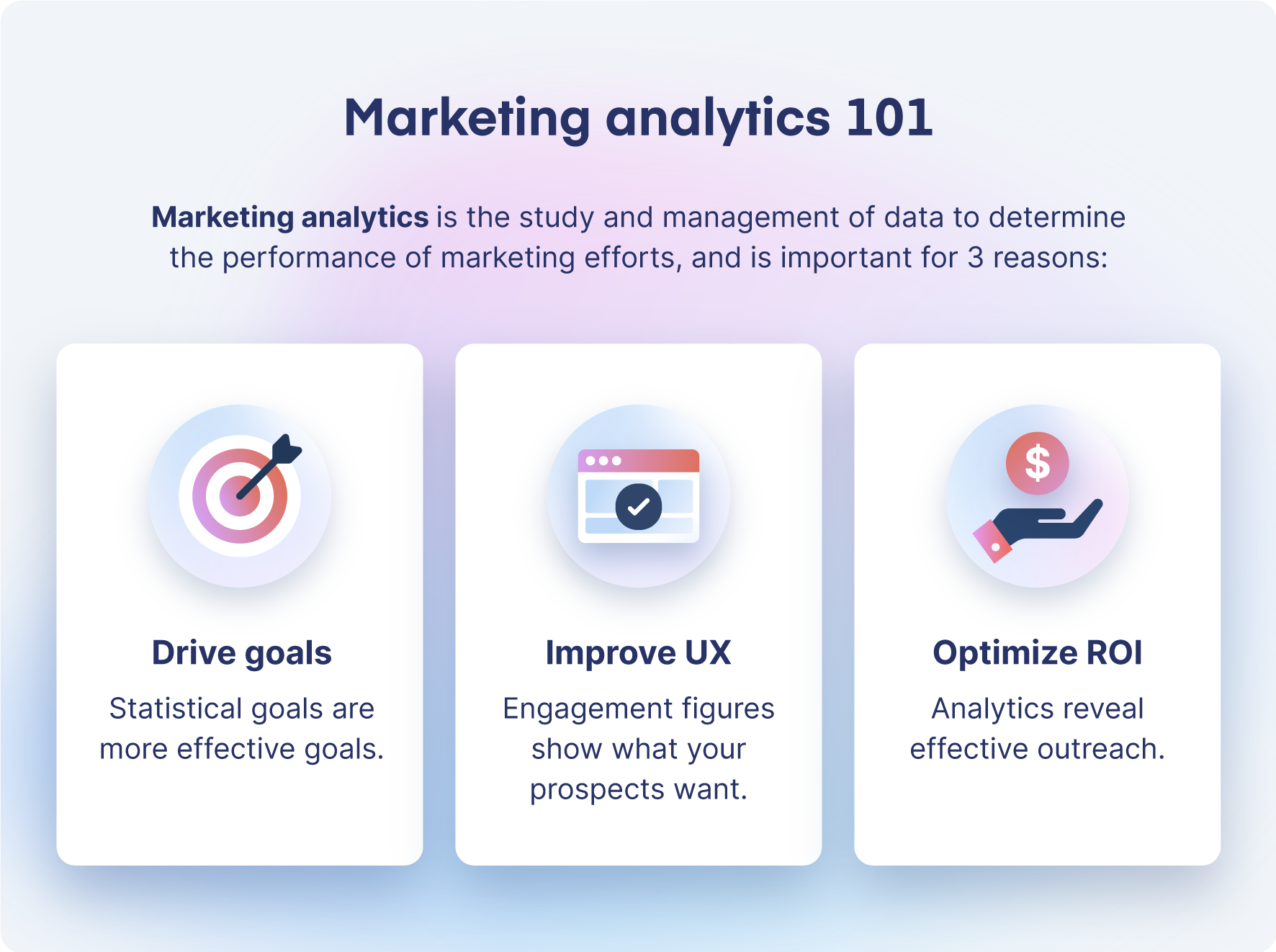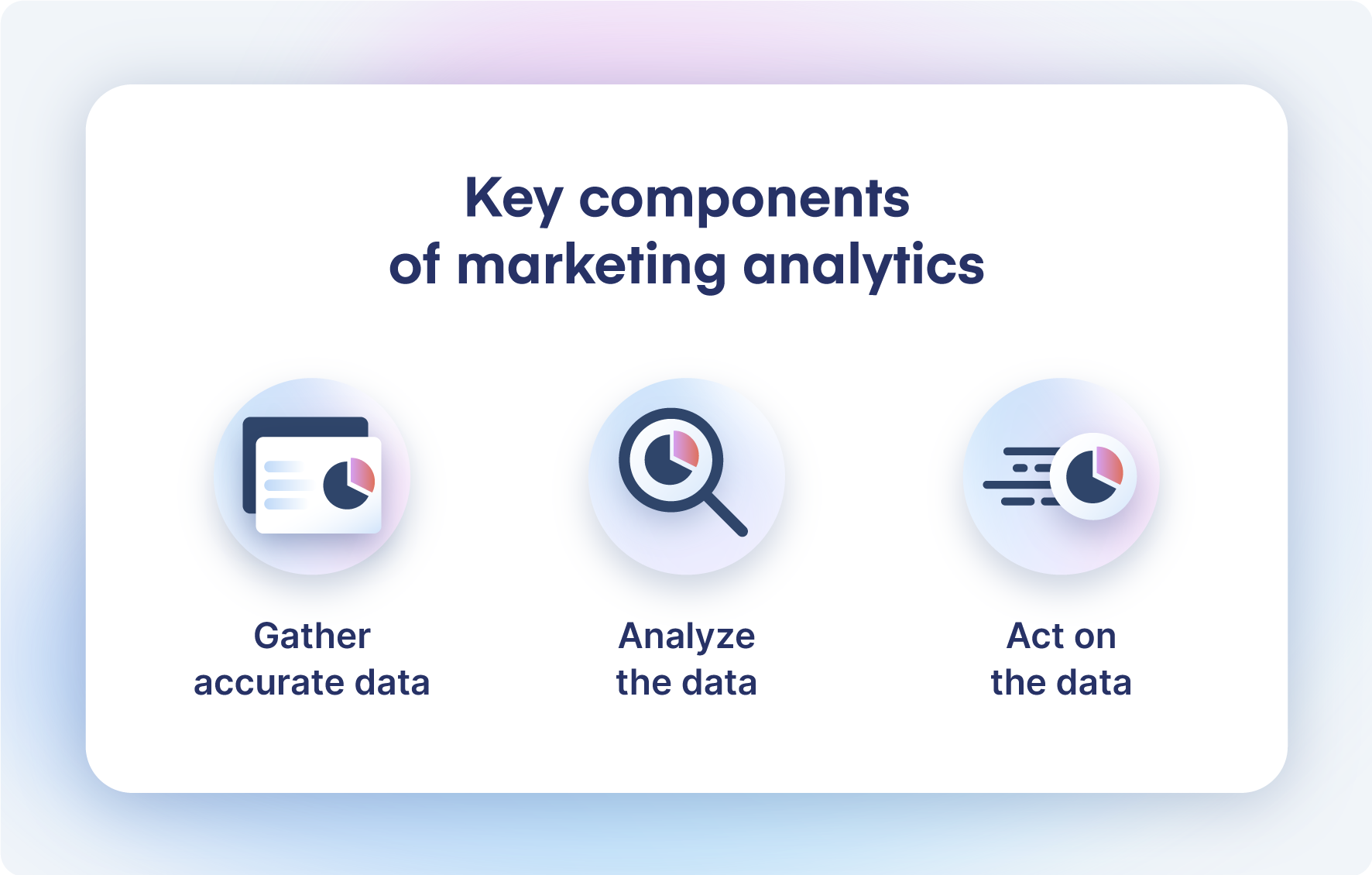Marketing analytics: a guide to measuring performance
Businesses that use marketing analytics are more likely to be profitable.
Wait, let’s try that again—businesses that use marketing analytics are six times more likely to be profitable than businesses that don’t.
Marketing analytics is the study and management of data to improve efficiencies and ROI across a business’ marketing efforts. You can use this process to drive short and long-term marketing strategies, improve user experience, ensure you are marketing to the right prospects, and determine what campaigns are or are not working.
In this article, we will detail what marketing analytics is, why it’s important, and how Clearbit can aid in your data collection efforts.
What is marketing analytics?
Marketing analytics is the study and management of data to determine the performance of marketing efforts. This data sheds light on the status of a business’s marketing, and can optimize ROI, influence future marketing decisions, and improve the customer experience.
Businesses can apply analytics to any method of marketing or prospect interaction such as the performance of paid advertising, landing pages, calls to action, content marketing, lead magnets, and more. Overall, this method makes sense of marketing efforts so a business can operate as efficiently as possible.
Why is marketing analytics important?
Marketing analytics is important because you can use it to drive goals, improve UX, and optimize ROI.
Drive goals
Marketing goals without proper statistical qualifiers are ineffective. Instead, use analytics to understand historical trends and drive effective goal-setting.
When businesses evaluate past marketing performance, they should be doing so from an analytical standpoint. Let’s say a company is looking back at its Q3 marketing performance and uncovered that the conversion rate on its PPC campaigns for those months was 2.75%. With that data, businesses can ask a number of important questions: How does the Q3 PPC performance compare to Q2 and Q1? Is the conversion rate trending upward or downward? In either case, what has changed from a content perspective?
Once a business fully understands its historical analytical trends, it can set effective goals. In any situation, companies should be setting goals that are SMART—specific, measurable, achievable, relevant, and time-bound—to operate as efficiently as possible. Referencing the example above, a good goal-setting statistical approach could be “increase PPC conversions from 2.75% to at least 3.25% by the end of Q4.”
When marketing analytics are used to examine historical trends, businesses can set SMART goals that directly impact positive performance.
Improve Consumer Experience
When you actively monitor marketing analytics, you naturally uncover what your ideal customer profile values most.
An ideal customer profile (ICP) is a snapshot of the perfect-fit customer for your business. When crafting assets like advertising campaigns, email marketing, website copy, or any other messaging, keep your ICP in mind. Once that has been established, marketing analytics can help you find opportunities to improve the consumer experience for the prospects that matter most.
Let’s say a business wants to improve its website homepage. They can A/B test the page with two different headlines and monitor the results. If, for example, homepage A has a much better conversion rate and a lower bounce rate than headline B, that means that homepage A is what the business’ ICP values more.
This analytical approach can be applied to landing pages, blog posts, and any other asset to improve the consumer experience and move one step closer to a fully-optimized website.
Optimize ROI
Meticulously analyzing your marketing efforts through the lens of marketing analytics will uncover endless opportunities to improve your return on investment.
The main benefit of pairing analytics with ROI analysis is understanding where you can get the most out of your budget. Businesses have limited resources, and it’s crucial to determine what marketing methods are working and what methods are ineffective and need to be cut.
For example, a business may be running PPC campaigns on Facebook, LinkedIn, and Instagram simultaneously. Through marketing analytics, the company can examine the performance of its campaigns across all three platforms to come to a number of important conclusions: Which campaign is most effective? If a campaign is low-performing, should it be cut or reworked? Are there any trends from the highest performing campaign that can be used to improve the lowest performing?
Marketing analytics plays an important role in optimizing ROI—shining light on any well-performing marketing that should be invested in, and any activities that should be cut.

Where does this data come from?
Marketing analytics requires data, and that can come from three different sources: first-party, second-party, and third-party.
First-party data
Your organization will collect first-party data. This can include website analytics, intent data, purchase history, contact information, and any other data points on the prospects and customers that interact with your business. First-party data is typically most useful for an organization because it comes directly from the consumers that interact with them.
Second-party data
Second-party data is data that another organization gathers. If Company A shares its’ first-party data with Company B, then Company B receives second-party data. This type of data sharing typically involves businesses that are trusted partners and share a similar customer base.
Third-party data
Third-party data is data that an outside source that has no affiliation with your business or industry gathers. Organizations with pre-defined criteria typically gather this data en masse. This criteria can range from “consumers that completed this survey” to “consumers that like dogs.” While these data sets can be useful for a business, they are not as reliable as first- or second-party data.
Key components of marketing analytics strategy
Now that we’ve touched on why this concept is important, we will cover the key components of a successful marketing analytics strategy.
Gather accurate data
Plain and simple, a successful marketing analytics strategy requires quality data.
If you’re basing your marketing strategy on data that is outdated, incomplete, or otherwise incorrect, your actions in response to that data won’t be useful. Ensure that the data you base your decisions on is relevant and error-free.
As we touched on above, the best type of data to use for marketing analytics is first-party data, and you can gather this information with tools we offer at Clearbit. Through our Clearbit Reveal capabilities, you can see exactly who is browsing your website, what pages they visit, and what business they affiliate with—if B2B.
Data enrichment capabilities make sure your person and company data entries are always up to date, whether your records are a bit dated or if you are verifying information from third-party sources, and a quality web page analytics tool can give insight into the performance of paid ads and how prospects interact with your website.
At the end of the day, where you are gathering marketing analytics data from is less important than the accuracy of the data itself.
Analyze the data
Now that you have the data, conduct an analysis to determine how your marketing is performing.
Start by congregating everything into one source such as an analytics dashboard or even something as simple as a spreadsheet. From here, you can dive deeper to spot trends in your marketing performance—both good and bad—to determine where you are coming up short, and areas you succeed in.
It’s important to dig deep into every facet of your marketing strategy. Compare how performance stacks up to previously defined SMART goals or other important KPIs. For example, in our hypothetical situation at the top of the article, a business looking to improve their PPC performance set a goal to “increase PPC conversions from 2.75% to at least 3.25% by the end of Q4”. This business could analyze its data to determine how its campaigns performed—were the goals met? If not, what are some key takeaways that can be used to drive future performance?
When a business analyzes its marketing analytics, it can take an in-depth look at campaign performance and set the stage for future strategy and growth.
Act on the data
All of the prior data acquisition and analysis is irrelevant if you don’t act on it.
While it’s easy to make changes in the short term, it’s also important to embed a marketing analytics culture in your decision-making and long-term strategy. The transition to full-scale adoption of analytics may be difficult, but it would be prudent to hire analytical professionals or create a company-wide analytics department to aid in operations.
When you shift your marketing efforts to focus on ROI and its data, your organization will become more efficient, profitable, and effective.

Marketing analytics FAQs
Finally, we will wrap up with a few frequently asked questions about marketing analytics.
How can I adopt marketing analytics into my day-to-day strategy?
To adopt marketing analytics in your data-to-day strategy, you should make a shift toward an analytical work environment. Taking actions such as hiring analytical-focused personnel and establishing a culture of analytics could be good approaches to adopting marketing analytics company-wide.
What are some important marketing analytics strategies?
Some important marketing analytics strategies are: gather accurate data, analyze that data across all of your marketing efforts, and implement marketing analytics throughout your organization for future decision-making.
How do organizations use marketing analytics?
Organizations use marketing analytics to drive their goals, improve the user experience, and optimize their ROI.
Marketing analytics requires quality data
Marketing analytics is a powerful process that can guide efficient marketing strategy, future strategic decisions, and improve ROI across the board. However, none of that is possible if your business is operating with out-of-date or incorrect data.
At Clearbit, we have the capabilities you need to gather first-person intent data and ensure that your database is always accurate—no matter where you get your data from.

